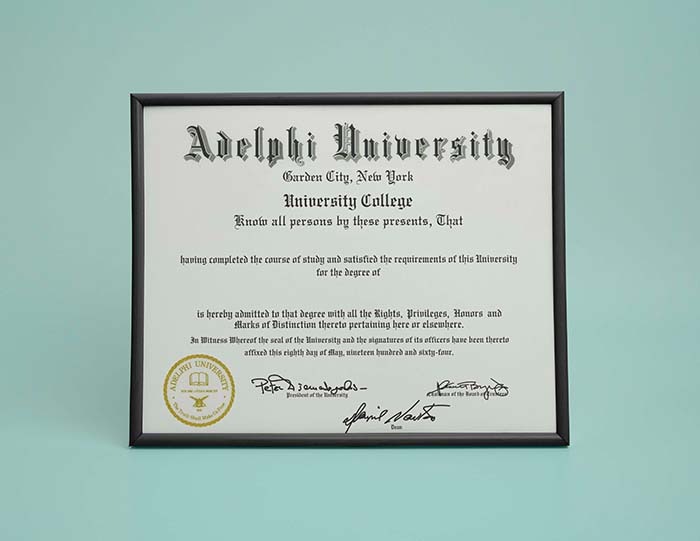A Guide to Replacing Your College Diploma
Losing your college diploma can be upsetting. After years of studying, attending classes, completing assignments, and overcoming challenges, your diploma represents all your hard work and achievement. A diploma is not only sentimental but also proves your qualifications for jobs, further education, or professional certifications. Losing it can feel like losing a part of your personal accomplishment. The good news is that you can replace your college diploma. With the proper documents and steps, you can restore your records and peace of mind. This guide outlines a simple, step-by-step process to help you replace your diploma safely and efficiently.


Understanding the Value of Your Diploma
A college diploma is not just a certificate; it is a symbol of your perseverance and dedication. It represents:
Time invested: Years of coursework, exams, and projects
Financial investment: Tuition, textbooks, and other education-related expenses
Personal growth: Knowledge gained and skills developed
Professional proof: A credential recognized by employers and licensing bodies
Keeping your diploma safe ensures you can use it for jobs, further studies, or personal records. Losing it can be stressful, but knowing your replacement options makes the process easier and gives peace of mind.
Common Reasons You May Need a Replacement
Understanding why diplomas get lost or damaged can help you prepare better. Some common scenarios include:
Lost or stolen diplomas: Moving homes, accidents, or theft can result in missing documents.
Damage from accidents or disasters: Water damage, fire, or natural wear over the years can ruin your diploma.
Name changes: Marriage, legal name change, or gender transition may require an updated diploma.
Errors in the original diploma: Mistakes such as misspelled names, incorrect degree titles, or missing honors require correction.
Duplicate copies: Many graduates want extra copies for display, gag gifts, or safe storage.
Knowing your reason helps you follow the proper steps and communicate clearly with your college.
How to Replace a Lost or Damaged Diploma?
Replacement diplomas are issued by your college or university’s Registrar’s Office.
Step 1: Contact Your College Registrar’s Office
Your college or university’s Registrar’s Office will issue replacement diplomas. When contacting them:
Visit the school website to find the Registrar’s contact information.
Inquire about the replacement process, required documents, and fees.
Ask about typical processing times.
Each school has its own procedures. Some may accept online requests, while others require submitting physical forms. Privacy laws, such as the Family Educational Rights and Privacy. Act (FERPA), protect your educational records, so only you—or someone legally authorized—can request a replacement.
Step 2: Gather Required Documents
Before submitting a request, prepare the necessary documentation. Typical requirements include:
Government-issued photo ID (passport, driver’s license)
Proof of graduation or transcript
Social security number (or equivalent)
Written request or completed form provided by the Registrar
Gathering all required documents beforehand helps prevent delays. If you submit your request by mail, some colleges may also ask for notarized forms.
Step 3: Submit Your Official Request
Replacement requests are usually formal. Here’s how to proceed:
Check your school’s process – Some provide downloadable forms; others have online submission portals.
Complete the form carefully – Include your full name at the time of graduation, the degree awarded, and graduation date.
Attach identification – This protects against identity theft and fraud.
Include payment – Most colleges charge a fee. Always check the acceptable payment methods.
Mail or submit online – Follow the instructions exactly. Confirm receipt if submitting by mail.
Following these steps ensures your diploma replacement request is processed efficiently and securely.
Step 4: Pay the Replacement Fee and Confirm Delivery
Replacement fees vary widely:
Bachelor’s diplomas: $20–$50 on average
Master’s or professional diplomas: $50–$100+
International or expedited orders: May cost more
Some schools provide tracking for mailed diplomas. If you need your diploma quickly, check whether expedited processing is available.
How Long Does It Take to Receive a Replacement Diploma?
Processing times depend on your institution and the time of year. Typical ranges include:
Standard processing: 2–8 weeks
Expedited requests: 1–3 weeks (additional fee may apply)
Request an official transcript or degree verification letter if you need proof of your degree before the replacement arrives. Many employers or licensing boards accept these as temporary proof.
What to Do If You Can’t Get a Replacement from Your School?
Sometimes, obtaining a replacement is more complicated:
Closed or merged colleges: Contact the state education department or accrediting agency to verify records.
Lost archives: Some schools keep records offsite. Ask about alternate verification options.
International diplomas: Contact the school directly or consult your home country’s education ministry for guidance.
Always use legal and verifiable channels when managing academic credentials. Do not forge or falsely represent your qualifications, as doing so can result in serious legal and professional consequences.
Using a Fake or Novelty Diploma: Pros and Cons
Fake diplomas are meant for fun or decoration and should never replace a genuine academic credential. Consider:
Pros: Fun display item, gag gift, conversation starter
Cons: Illegal to use as proof of education, could result in criminal charges or employment termination
Use novelty diplomas responsibly and only for personal or display purposes.
How to Protect Your Diploma Once You Get It?
Once you receive your replacement diploma:
Frame it with UV-protective glass to prevent fading
Store a digital copy in secure cloud storage or with a trusted backup service
Keep it in a safe place—avoid areas prone to water or fire damage
Consider insurance if the diploma has significant value for personal or professional reasons
Proper care helps ensure your diploma stays in good condition for years.
Tips for a Smooth Replacement Process
Start early: Replacement requests may take several weeks.
Double-check information: Ensure your name, degree, and graduation date are accurate.
Keep receipts: Save confirmation of payments and forms for reference.
Follow up: Contact the Registrar if you haven’t received your diploma within the expected timeframe.
Losing a college diploma can be stressful, but it doesn’t diminish your accomplishments. Fortunately, you can replace it safely and legally by following a few simple steps. Gather all required documents, then submit your replacement request according to your school’s procedures.
Once you receive your new diploma, store it properly to keep it in good condition. Each step ensures that your hard work and achievements are correctly recognized. Treat your diploma as a valuable symbol of your dedication and ensure it remains safe for years.
Frequently Asked Questions (FAQs)
How much does it cost to replace a college diploma?
Fees usually range from $20 to $100, depending on the school and degree type. Some universities may also charge extra for expedited processing or international delivery.
Can I get a copy if my university is closed?
Contact the state education department or the school’s accrediting agency. They can provide verification or guidance on obtaining a replacement.
How do I prove my degree without a diploma?
Request an official transcript or degree verification letter from your Registrar’s office. These documents are widely accepted as proof of graduation.
Can I replace my diploma if I changed my name?
Yes. Most schools allow you to request a corrected diploma with legal documentation of your name change.
How long does it take to get a new diploma?
Standard processing typically takes 2–8 weeks, but some schools offer expedited options for an extra fee.
Are there alternatives to a replacement diploma if I need proof urgently?
Es. Temporary alternatives include official transcripts, degree verification letters, and digital copies issued by the Registrar.
Can I frame my diploma safely at home?
Use UV-protective glass, avoid direct sunlight, and store in a low-humidity environment to prevent fading and damage.
